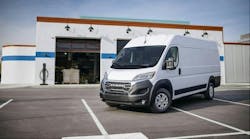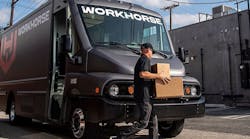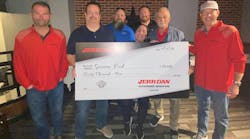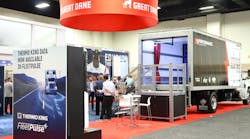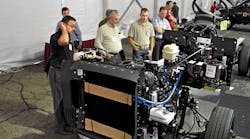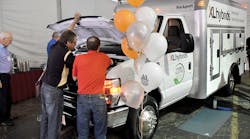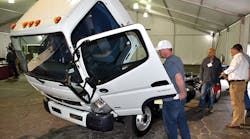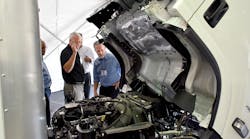Freightliner Custom Chassis Corporation (FCCC) is working on getting Meritor WABCO’s SmarTrac brake system into its MT products, according to technical sales manager Brian Caudell.
“It’s coming,” he said. “Hopefully in the next year and a half, it’s something you’ll see on our MT products.”
The SmartTrac family of Stability Control Systems integrates active safety systems technologies into a comprehensive suite of innovative products to meet specific operational needs: Anti-Lock Braking Systems (ABS); Automatic Traction Control (ATC); and Electronic Stability Control (ESC).
ATC provides improved stability when driving/accelerating on low-friction surfaces; improved traction under difficult conditions. It reduces the potential of jackknifing caused by excessive wheel spin during acceleration or in curves. When one drive wheel is spinning at a different speed than the other, ATC momentarily applies the brake until traction is regained. When both drive wheels are on a poor-traction surface, ATC automatically reduces engine power to attain optimum tire-to-road traction.
ESC is an active vehicle safety system that automatically intervenes when there is a high risk of directional instability that could lead to loss of vehicle control or rollover. The ECU constantly compares the vehicles actual movement to performance models using various vehicle sensors. If the vehicle shows a tendency to leave the driver’s intended path (oversteer or understeer) or exceed a critical lateral acceleration threshold, the system intervenes by selectively applying appropriate brakes to better align the vehicle to the driver’s path of travel, or speed thereby assisting the driver in maintaining control of the vehicle.
It automatically intervenes to assist the driver in maintaining directional control of the vehicle when encountering slippery road conditions or taking an evasive action; assists the driver in reducing the risk of rollover while in a curve or taking evasive action; and reduces the chances of a jack-knife and drift out condition through selective braking of the tractor and trailer; and helps to control and reduce tractor-trailer speed when lateral acceleration limits are about to be exceeded.
Caudell said FCCC planned to introduce the DD5 Detroit Diesel engine into its chassis in the fourth quarter, and the DD8 will be launched late this year or early next year.
Talking about the DD5, he said, “It is a smart, fuel-efficient design and will provide fuel economy leadership and efficient regeneration of the Diesel Particulate Filter (DPF). It has an optional integrated engine brake and the longest scheduled maintenance intervals in its class at 45,000 miles.”
The DD8 features a 260-350 hp range and a torque range of 660 to 1050 ft-lb and will launch with both engine and transmission power-take-off (PTO) options required for many vocational applications. The DD8 and DD5 sport a “B10 life” of 400,000 miles. The DD8 is expected to match or exceed the 45,000-mile maintenance interval of the DD5. Vehicles equipped with the DD8 will also feature the Detroit Connect Virtual Technician remote diagnostic service.
Other topics Caudell touched on:
• S2G propane chassis.
“It’s been primarily used in propane delivery, but is approved for box truck and stake body flatbed applications. It’s available in 24,000 to 33,000 GVWR. It’s built down a factory assembly line—not a conversion or aftermarket system. You get all the parts, including engine parts and fuel-system parts, through Freightliner’s parts and service network. It has a clean frame rail for easy body integration. The engine was developed by what is now Power Solutions International—8L, with 495 ft-lb of torque and 339 hp. It is 50-state, OEM-certified, CARB-compliant. We are in production right now. We’ve got a lot of fleets that have saved a lot of money by using propane versus using diesel.”
• Cummins 2017 ISB ATS.
“They have gone from a dual-canister system to a single system, so that we have to now manage the canister on the outside of the frame rail. The canister does have DPF and SCR incorporated in one, so it’s mounted on the outside of the frame rail, which makes it different for some of you mounting components on the outside of the frame rail. You’re not going to be able to do that on the right-hand side. On the MT55 model, you’re able to get it mounted inboard, and that’s with 190 and 300 wheelbase with 22.5-inch tires.”
• New 6.0L gas cooling system.
“Our surge tank was mounted on top of the radiator. We were able to go to an overflow bottle mounted to the right-hand side. We used that surge tank since 2010. That’s what we used with the Cummins engine when we were building them. It gives you a coolant system pressure of 16 psi. On the old surge tank, it was 9 psi. Body companies can get a bit more clearance over the radiator to get more aerodynamics in the hood. Later this year, we should be offering a low-coolant sensor.”
• Tuned Sachs shocks.
“They will be tuned specifically for the MT45 and MT55 chassis. The new shocks will give optimum comfort and improved roll stability for walk-in van customers.”
• Three-tank CNG system.
“We’ve been building alternative-fuel vehicles for at least the last 15 years. Our company is a fuel-agnostic company, so we offer diesel gasoline and also the CNG system. The chassis with a three-tank CNG system has a 52 gasoline gallon equivalent (GGE) with the tanks. We also have a two-tank system if you don’t need that much capacity or don’t have that large a wheelbase. We use the 6L V8 engine for the CNG chassis for this application.”
• Propane commercial chassis.
“We also do propane on the same engine. It has 308 hp and 367 ft-lb of torque with a GVW range of 24,000 to 23,000. The liquid propane tank is a 60-gallon tank, but it’s 48 usable gallons.”
• Protek telematics.
“We offer a telematics module on the MT product. It’s just the module itself, so fleets that want to get diagnostics on a daily basis have to sign up for the software service. But we put the module on there so it will tie on to the bulkhead door, cab dome light, cargo dome light, and seat belt rear door. We also run wiring to the brake pads, so when the brake pads wear low, it will send that to the home office and let them know it’s time to change them.”
• WEMC hydraulic disk brake.
“We incorporated a four-piston system. It has longer pad-replacement intervals. We have it on fleets that are in stop-and-go applications. They are able to get 92,000 miles out of a set of pads versus 45,000 on our standard pads. Pistons on each side of the rotor apply force evenly to their respective pad. There is no sliding caliper mechanism to maintain.”
• WEMC corrosion-resistant ABS.
“It resists heat breakdown. There’s a no-flake microstructure and the ABS teeth maintain integrity in corrosive environments, resisting corrosion-induced ABS signal deterioration.”
• OPTIVIEW instrument panel.
It’s the industry’s first fully integrated, all-digital LCD instrument cluster. Designed in collaboration with Mercedes-Benz, OptiView is inspired by the current S-Class dash. This user-friendly system features a bright, anti-glare display, touch screen radio and input operation, camera system views and Bluetooth steering wheel controls.
Click on articles under "Related" to continue reading NTEA 2017 Truck Product Conference coverage.
